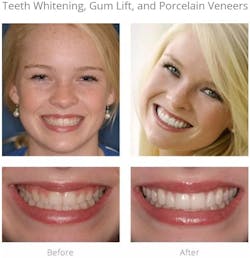If you’re interested in attracting smile makeover patients via your website, an online smile gallery is a necessity. In 2009, Sesame Communications conducted what I consider a landmark study and published a white paper titled, “How consumers choose cosmetic dentists online.” To get answers, Sesame recruited patients who were searching for a cosmetic dentist and then connected them, by phone and internet, to a researcher who could study them as they searched. The researcher could see their screens, and patients were asked to share their thoughts out loud while they navigated the sites.
The results were compared to another study conducted by Sesame about how consumers choose general dentists. Researchers learned two important things. First, cosmetic dentistry patients approached the websites differently than general dentistry patients. Those looking for general dentistry nearly always visited the doctor bio page first, and those looking for cosmetic dentistry headed straight to the procedures page looking for signs that the dentist had expertise in the procedure they were considering. They also wanted to see a smile gallery.1
Second, the researchers learned that patients used the smile gallery as the primary way to determine the expertise of the dentist. The quality of the work displayed was critical. One bad result in the gallery often sent patients off to different websites.
My experience with marketing cosmetic practices, along with surveys of our clients’ patients, confirm both these findings. So, let’s discuss how to build an effective smile gallery.
Use an emotional appeal
A foundational principle of all marketing is that emotional appeals are much more effective than those that are purely logical. Marketing research repeatedly demonstrates this. One study cited often is from the Institute of Practitioners in Advertising (IPA), the leading trade organization in the United Kingdom. In 2009, Roger Dooley, a marketing consultant and neuromarketing expert, published an analysis of 1,400 marketing case studies in the databank of the IPA. The analysis found that purely rational appeals used by their member marketing agencies were successful (as measured by profit gains) only 16% of the time. Emotional appeals, however, resulted in very large profit gains 31% of the time—almost twice as often.2
The key to building a smile gallery is to look past the logic of displaying work that measures up to critical scrutiny and focus instead on how your smile gallery makes online visitors feel. It’s those positive feelings that will encourage them to call for an appointment.
Use the power of imagination
Douglas Van Praet, a well-known marketing pioneer, explains the marketing principle that’s at work here in his book, Unconscious Branding. In a chapter titled “Lead the Imagination,” he discusses how to encourage people to make personal improvements. He uses the example of the marketer Shirley Polycoff, who popularized the use of hair color in the 1950s. When you want to help someone make a personal improvement, the marketing task is getting them to imagine themselves if they make that improvement.3 Van Praet said that to encourage people to do something new, they need to be empowered “to project themselves and their identity into the experience.”3
Applying this to cosmetic dentistry, you want people to imagine themselves with that new smile. The way to do this on your website is to post photos of your work that show the full faces of people whom your website visitors can identify with. Van Praet said, “In today’s market economies, people buy brands because they’re buying into what they wish their lives would become. Imagination is the vehicle that makes it possible for us to understand what that might be like.”3
An illustration of the effectiveness of this technique is the marketing campaign employed by a Porsche dealer in Toronto. This dealer took a new Porche 911 to some of Toronto’s most affluent neighborhoods. The car was then photographed in front of each house, and this photo was then printed on a flyer with the slogan, “It’s closer than you think.”
The dealer dropped these into the mail slots of each home, and the campaign was wildly successful. The most successful direct mail campaigns hope for a response rate in the low single digits. The results of this imaginative campaign? Thirty-two percent of those contacted called the dealer for a test drive.4
To be most effective, your smile gallery must help your prospective patients imagine themselves with that beautiful smile. You do that with full-face photos of your work. Ideally, you should also enable visitors to see close-up details by clicking on the photos or another link.
Save your retractor views for the professional lectures! Yes, you want patients to see the teeth clearly, but they will be turned off by gross views of gums exposed by cheek retractors.
Tell a story about each case
It almost goes without saying that to help your patients decide on treatment, your photos need to explain what the procedure is. But don’t pass up the opportunity to use your gallery to also demonstrate that you’re a caring and personable practitioner. Do that by telling a little story about each case. “Mary’s grandson asked her why one tooth was crooked. Embarrassed, she asked Dr. Jones to correct the tooth. Using only two porcelain veneers, Dr. Jones gave her this beautiful smile.” Presenting a case like this shows patients that you treat people, not just teeth. Showing your warmth will help create the trust needed to encourage people to call you.
Acquire patient consent
You may feel uneasy about asking your patients for consent to display their photos publicly. Don’t be. Our clients tell us they’re surprised at how willing their patients are to give their consent. “They’re flattered that our practice wants to use their photo,” one client told us.
To make it easier, include the consent form as part of your patient registration form. Right below the medical history and just above the line for their signature, include a consent statement that asks patients to check the box if they agree, or cross it out if they don’t agree. My experience with this is that more than 90% of patients gave me consent to display their full-face photos.
How many cases should you display?
While having dozens of cases on display can create a feeling that you’re an expert, patients aren’t going to look at all those photos. They’ll hit their limit at about five or 10 cases. If you have photos organized by the type of procedure, three or four examples of each procedure should be fine.5
At all costs, avoid displaying photos of cases that did not turn out well. One bad case will send visitors to a different website.1 All the work displayed must be quality work to avoid sending visitors to the competition. Showing two or three quality cases is better than showing 10 cases if one of the 10 shows a poor result.
A smile gallery example
From the smile gallery of one of our clients—Dr. Fred Arnold of Lexington, Kentucky—here is a sample case (figure 1).
The bottom line is that it is possible to attract smile makeover patients on the strength of your website alone. We have seen it happen! It requires a beautiful website that brands you as a dentist who will make your patients beautiful, that clearly explains the procedures, and that includes an effective smile gallery.
Editor's note: This article appeared in the October 2021 print edition of Dental Economics.
References
1. How consumers choose cosmetic dentists online. Sesame Communications Whitepaper 2.3. Seattle, WA: Sesame Communications; 2009:3.
2. Dooley R. Emotional ads work best. Neuromarketing. July 27, 2009. Accessed July 29, 2021. https://www.neurosciencemarketing.com/blog/articles/emotional-ads-work-best.htm
3. Van Praet D. Unconscious Branding: How Neuroscience Can Empower (and Inspire) Marketing. St. Martin’s Press; 2014:148.
4. Joseph N. Toronto Porsche dealer redefines direct marketing. Carbuzz. July 30, 2012. Accessed July 15, 2021. https://carbuzz.com/news/toronto-porsche-dealer-redefines-direct-marketing.
5. Hall DA. Building an effective smile gallery. Infinity Insights. July 30, 2018. Accessed July 15, 2020. https://www.infinitydentalweb.com/blog/ building-an-effective-smile-gallery/
David A. Hall, DDS, AAACD, graduated with honors from the University of Minnesota School of Dentistry and ran a private practice in Cedar Rapids, Iowa, for many years. In 1995, he launched a website promoting his own dental practice. After requests from other dentists for help with their websites, he founded Infinity Dental Web in 2009, a marketing agency that does digital marketing for dentists. Dr. Hall may be contacted at (480) 273-8888.
About the Author

David A. Hall, DDS, AAACD
DAVID A. HALL, DDS, AAACD, graduated with honors from the University of Minnesota School of Dentistry and ran a private practice in Cedar Rapids, Iowa, for many years. In 1995, he launched a website promoting his own dental practice. After requests from other dentists for help with their websites, he founded Infinity Dental Web in 2009, a marketing agency that does digital marketing for dentists. Dr. Hall may be contacted at (480) 273-8888.

